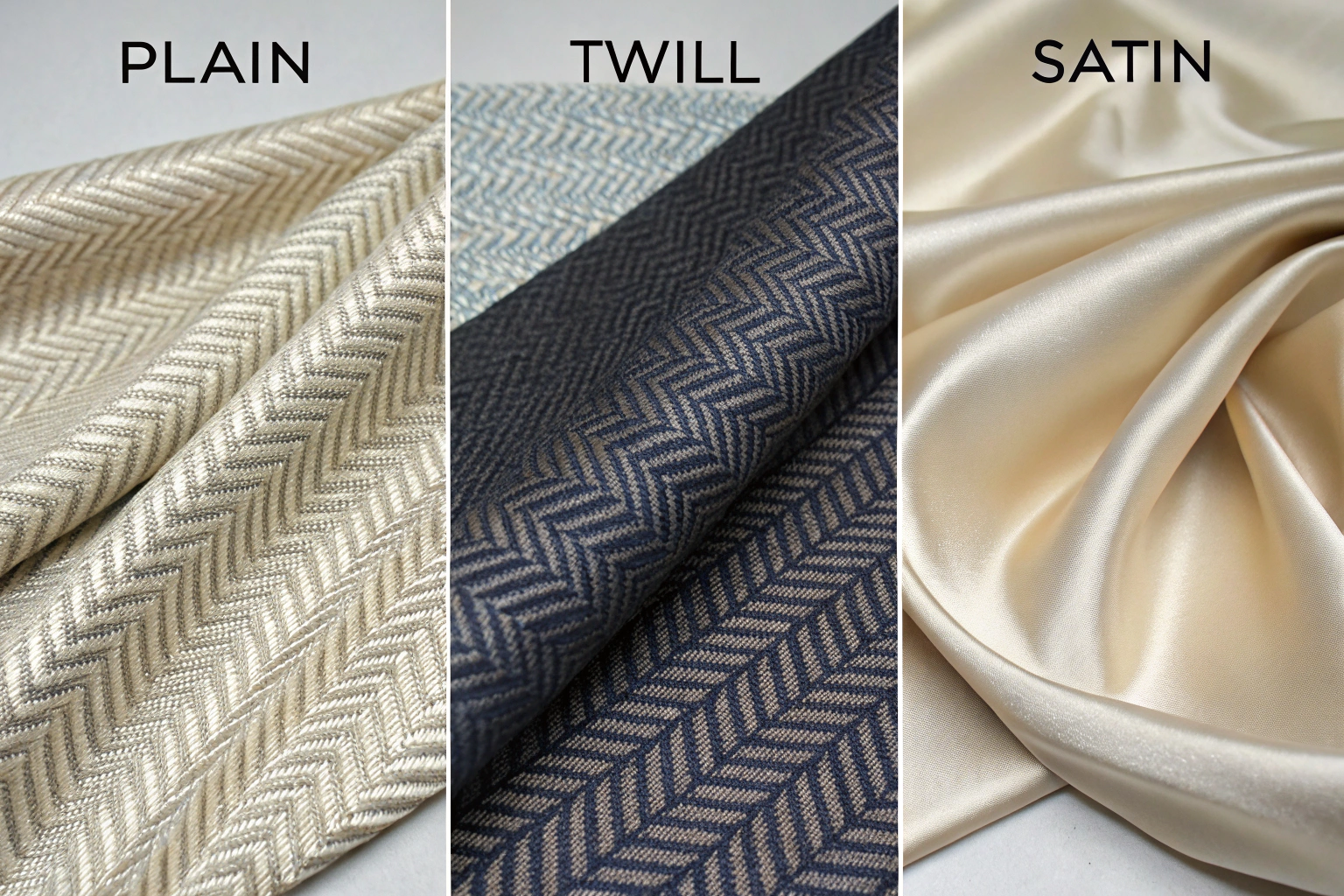Choosing the right fabric weave can feel overwhelming. You have a design in mind. You know the feel you want. But with so many weave types, how do you pick the right one? This decision impacts your product's durability, appearance, and cost. Getting it wrong can lead to unhappy customers and lost revenue. I see this challenge often with our clients in the US and Europe.
The choice between plain, twill, and satin weaves depends on your specific needs for durability, texture, drape, and aesthetic. Plain weave is the strongest and most cost-effective, twill weave is durable with a distinctive diagonal pattern, and satin weave is the most luxurious with a smooth, shiny surface. Your final decision should balance your design vision with practical requirements like care and budget.
This guide will break down each weave in simple terms. You will learn their unique strengths and weaknesses. I will share insights from our 20 years of experience supplying fabrics worldwide. By the end, you will be able to confidently select the perfect weave for your next project.
What is a plain weave and when should I use it?
Plain weave is the simplest and most common fabric construction. It is made by passing the weft yarn over and under each warp yarn in a consistent crisscross pattern. Think of it as the bread and butter of the textile world. It is fundamental, strong, and incredibly versatile. If you have ever worn a standard cotton shirt or slept on cotton bed sheets, you have experienced plain weave.
This straightforward interlacing creates a fabric that is inherently strong, durable, and often more affordable. Because of its tight structure, it tends to be less prone to snagging compared to other weaves. However, it can be less flexible and may wrinkle more easily. Common examples you will find in our stock include cotton poplin, chiffon, and taffeta. We produce vast quantities of these for global brands, ensuring consistent quality.
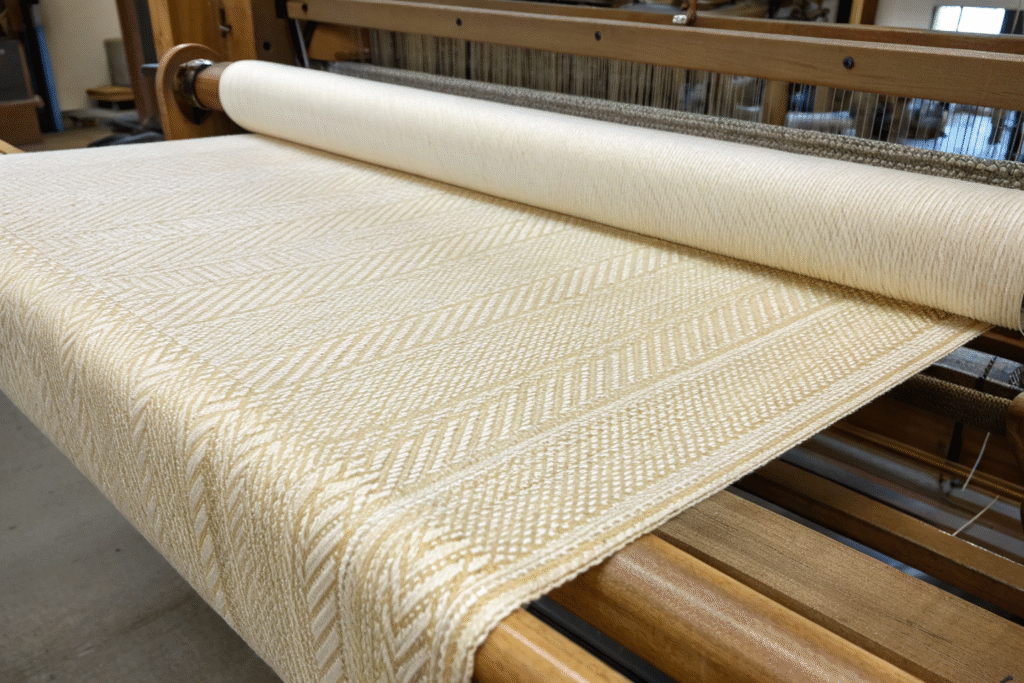
What are the key characteristics of plain weave?
The defining traits of plain weave are its strength, flat surface, and high stability. The simple over-under pattern creates a fabric that is very resilient to wear and tear. It has a relatively matte finish and can feel crisp or soft depending on the fiber origin used, like cotton or silk. This weave also provides an excellent base for printing, as its flat surface allows for sharp, clear designs. Its durability makes it a top choice for technical fabrics that require reliability, such as those used in uniforms or industrial applications.
Where is plain weave most commonly applied?
Plain weave is everywhere. Its applications are vast because it is so adaptable. In fashion, it is the go-to for classic dress shirts, blouses, and linings. In home textiles, it forms the basis of many bed sheets, curtains, and tablecloths. Because it can be made very tight, it is also used for windproof fabrics in outerwear. We work with many US clients who choose our plain weave organic cotton for their sustainable apparel lines, appreciating its straightforward construction and eco-friendly credentials. Its versatility across fashion essentials and functional uses is unmatched.
How does twill weave enhance durability and aesthetics?
Twill weave is easily identified by its distinctive diagonal rib pattern. This pattern is created by passing the weft yarn over one or more warp yarns and then under two or more warp yarns. This offset sequence creates the classic diagonal lines. You see this every day in materials like denim for jeans and gabardine for trench coats. It is a weave that combines robustness with style.
The twill structure makes the fabric more pliable and resistant to wrinkling than plain weave. It also tends to be heavier and more durable, which is why it is a favorite for workwear and high-traffic garments. However, the diagonal texture can make it more prone to showing stains and can have a right and wrong side. Our CNAS-certified lab constantly tests twill fabrics for attributes like colorfastness and shrinkage to meet international standards.
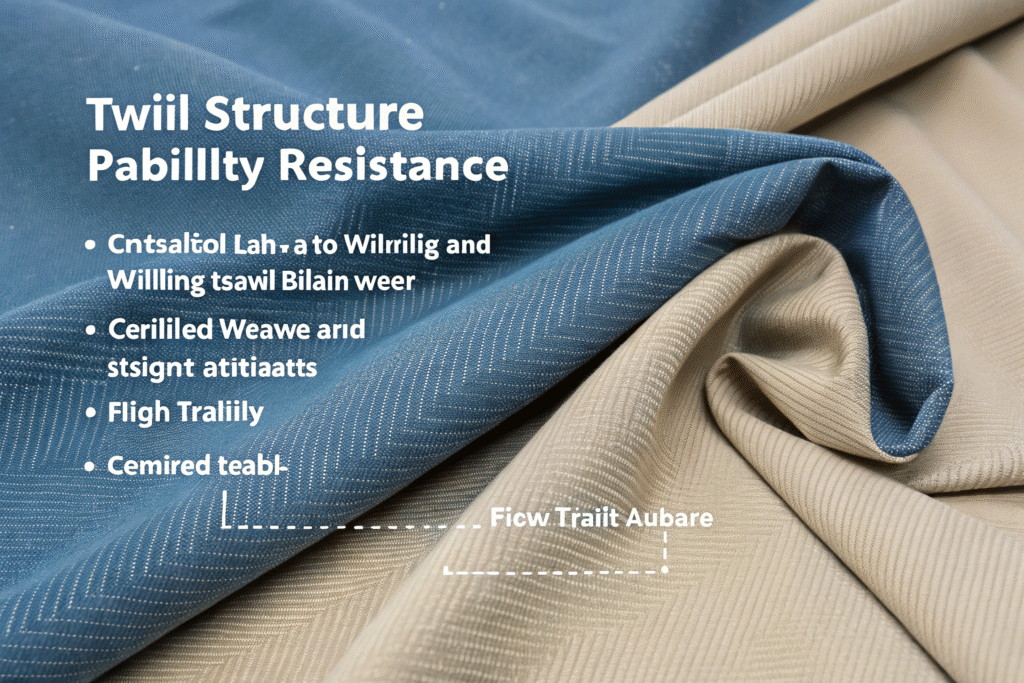
What makes twill weave so strong and flexible?
The secret to twill's strength and flexibility is its construction. The float yarns (where the yarn goes over multiple threads) create a fabric that is less rigid than plain weave. This allows it to drape beautifully and move with the body. The diagonal structure distributes stress across the fabric more effectively, enhancing its durability. This makes it ideal for performance fabrics that need to withstand abrasion. Furthermore, this weave is excellent for creating blends with sturdy synthetic fibers like polyester, amplifying its long-lasting properties.
What are the popular types of twill fabric?
The most famous twill fabric is, without a doubt, denim. Its iconic blue face and white back are a result of the twill weave. Another classic is drill, a strong fabric used in khakis and uniforms. Cavalry twill is a heavier type often used in riding gear and winter coats. We also produce sophisticated jacquard designs on a twill base, adding intricate patterns to the durable structure. Many of our clients in the sportswear sector leverage our twill-based moisture-wicking fabrics for pants and jackets, combining the aesthetic of twill with modern functionality.
Why is satin weave known for its luxury and smoothness?
Satin weave is the epitome of luxury. It is characterized by long yarn floats on the surface. These floats are created when the weft yarn passes over multiple warp yarns (or vice versa) before going under one. This minimal interlacing creates a incredibly smooth, glossy, and soft surface that reflects light beautifully. Fabrics like silk charmeuse and antique satin are prime examples.
This luxurious feel and high sheen make satin a favorite for evening gowns, lingerie, and high-end linings. However, the long floats are also its weakness. They can be easily snagged by sharp objects, making the fabric less durable for everyday use. It can also be slippery to work with during garment construction. We address this by offering satin weaves made from different materials, including durable BAMSILK and Tencel™ blends, which provide a more resilient luxury.
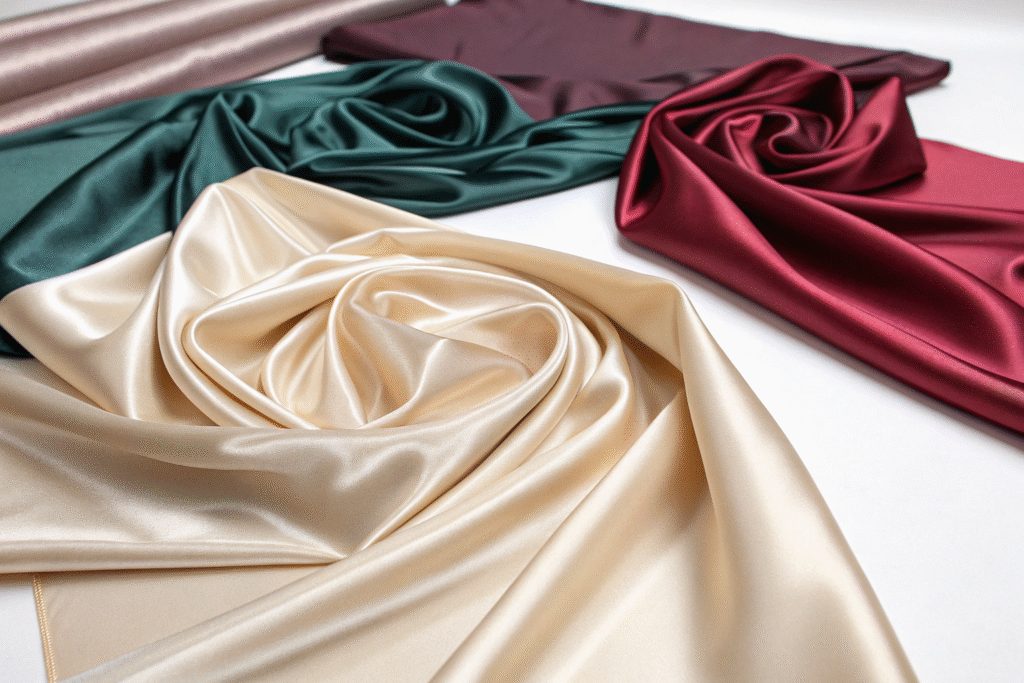
How is the signature sheen of satin created?
The sheen is a direct result of the long floats on the fabric's surface. With fewer interlacings, the yarns lie flat and uninterrupted, creating a larger area to reflect light. This creates that characteristic glossy appearance. The type of fiber used greatly amplifies this effect. Silk fibers have a natural triangular structure that refracts light, giving silk satin its unparalleled glow. Similarly, semi-synthetics like acetate are often used to create affordable fabrics with a high shine, perfect for linings and decorative items.
What are the common uses and variations of satin?
Satin is predominantly used where appearance and feel are paramount. It is a star in bridal and evening wear, luxurious lingerie, and elegant home décor items like pillowcases and draperies. Variations include charmeuse, which is very light and fluid, and duchesse satin, which is heavier and more structured. We are also at the forefront of innovating eco-fabrics in this category, developing satins made from recycled polyester that offer a sustainable luxury option for our environmentally-conscious partners in Europe.
How to compare weaves for your specific project?
Now that you understand the basics, how do you make the final choice? The best way is to systematically compare the weaves against your project's checklist. You need to consider factors like the end-use, desired care, budget, and aesthetic. A workwear uniform has very different needs than a delicate evening dress.
Creating a simple comparison table can help visualize the differences. I often do this with my clients to clarify their options. This practical approach ensures you don't overlook a critical factor that could affect your product's success in the market.
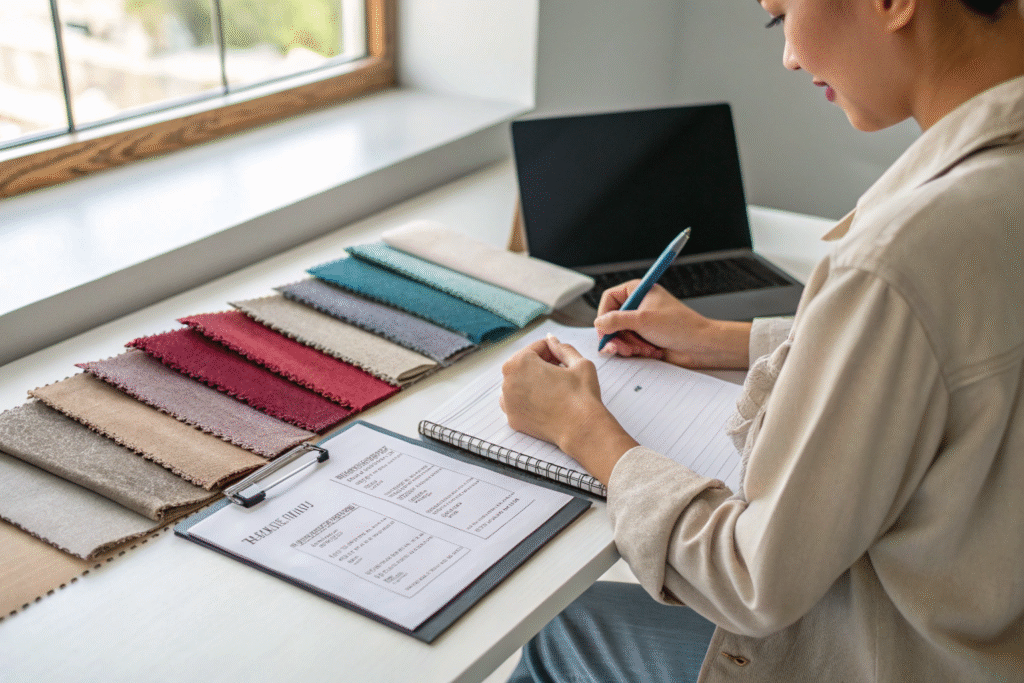
What factors should you consider when selecting a weave?
You should start with these key questions:
- Durability Needs: How much wear and tear will the garment endure? For high abrasion, choose plain or twill.
- Aesthetic Vision: Do you want a matte, textured, or glossy look? This points directly to plain, twill, or satin.
- Drape and Feel: Should the fabric be stiff, fluid, or soft? Satin offers the best drape, while plain can be crisper.
- Care and Maintenance: How will the garment be cleaned? Twill resists wrinkles, while satin often requires delicate care.
- Budget: Plain weave is generally the most cost-effective, while satin, especially silk satin, can be more expensive.
Can you create a quick comparison guide?
The table below provides a high-level overview to aid your decision-making process.
| Weave Type | Key Strength | Common Uses | Best For |
|---|---|---|---|
| Plain Weave | High Durability & Stability | Shirts, Bed Sheets, Poplin | Eco-Friendly Innovations like organic cotton, everyday essentials |
| Twill Weave | Durability with Diagonal Texture | Jeans, Jackets, Workwear | High-Performance Fabrics and durable fashion like denim |
| Satin Weave | Luxurious Drape & Shine | Evening Gowns, Lingerie | Fashion Essentials requiring a high-end, luxurious aesthetic |
Conclusion
Choosing between plain, twill, and satin weave is a fundamental step in bringing your design vision to life. Plain weave offers unmatched strength and versatility. Twill weave delivers rugged durability with a classic diagonal texture. Satin weave provides a luxurious feel and beautiful drape for high-end creations. Your choice ultimately shapes the functionality, look, and cost of your final product.
We hope this guide empowers you to make a confident decision for your next collection. Remember, the right fabric partner can make all the difference. If you are ready to source high-quality fabrics with seamless global logistics and expert quality control, we are here to help. Let's collaborate to create something exceptional.
For inquiries about sourcing fabrics or developing your own clothing line, please contact our Business Director, Elaine, at elaine@fumaoclothing.com. We look forward to supporting your success.

